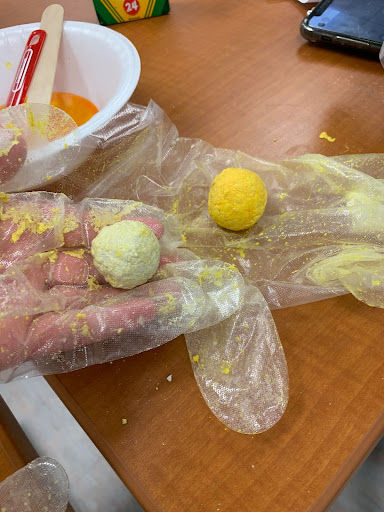InTASC Standard:
Standard #4: The teacher understands the central concepts, tools of inquiry, and structures of the discipline(s) he or she teaches and creates learning experiences that make these aspects of the discipline accessible and meaningful for learners to assure mastery of the content (InTASC, 2013).
Brief Description of Evidence:
In the fall of 2022, in my EDUC 224 Introduction to Scientific Inquiry class, we partnered up and devised a lesson plan over several weeks. A lesson plan is a tool to help teachers prepare for what they will teach in class. For our lesson, we taught about the polymers found in bouncy balls. We had students predict how high they thought several balls would bounce. Then we showed a short video explaining how polymers work. Vygotsky’s Scaffolding Theory is where one student learns better when paired with a student with more knowledge of the subject. So we split the class into groups of 2 and had them make their bouncy balls, having each group use a different cross-linker. Once students’ balls were finished, we had students test how well their balls bounce compared to a rubber bouncy ball using bar graphs. We ended the lesson by discussing why some balls bounce higher than overs.
Analysis of What I Learned:
This assignment taught me how to turn a not-popular topic into an interesting lesson for my students. Some topics in science aren’t always appealing to children, but finding a way to turn those topics into fun learning opportunities students are more likely to obtain the knowledge that was taught. I also learned that Vygotsky’s Scaffolding “focuses on a student’s ability to learn information through the help of a more informed individual” (Vygotsky’s Scaffolding: What It Is and How to Use It, 2023). By putting students with a partner, our students learned more information from our lesson and had the best chance of succeeding.
How This Artifact Demonstrates my Competence on the InTASC Standard:
This demonstrates my competence with Standard #4 because in our lesson I used central concepts of polymers to make a lesson fun and interactive for students. I used tools of inquiry by asking the students questions as the lesson went along, gathering information throughout the lesson, researching many different things about polymers, and planning the lesson with a partner to ensure everything went correctly. I gathered information through Vygotsky’s Scaffolding like “If a concept or skill is something that a student could do with the help of a more knowledgeable other, then that concept or skill is something they could perform on their own after learning it with support” (Udemy, 2021). I devised alternatives for the cross-linkers to challenge the students and worked with a partner to ensure our lesson went smoothly. To show the structures of disciplines I planned out every detail of the lesson and ensured that our activity had all the building blocks to engage the students. The learning experience was meaningful to learners through the scientific method and turning a not-always-fun lesson into a STEM lesson.












Pictures are from the lesson plan implementation.
Council of Chief State School Officers. (2013, April). Interstate Teacher Assessment and Support Consortium (InTASC) Model Core Teaching Standards: A Resource for State Dialogue. Washington, DC: Author.
Sarikas, C. (n.d.). Vygotsky scaffolding: What it is and how to use it. Vygotsky Scaffolding: What It Is and How to Use It. Retrieved December 9, 2022, from
https://blog.prepscholar.com/vygotsky-scaffolding-zone-of-proximal-development
“Udemy.” An Introduction to Using Vygotsky’s Scaffolding in the Classroom, July 2021,